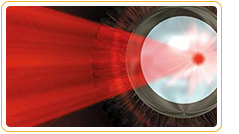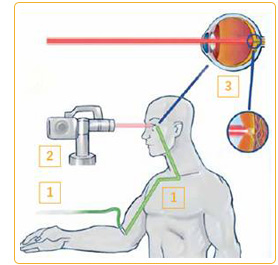Photodynamic Therapy (PDT)

What is Photodynamic Therapy?
Photodynamic therapy (PDT) uses a light-activated dye (Verteporfin) and a special non-thermal laser in order to help seal up abnormal blood vessels.
How is Photodynamic Therapy Performed?
Photodynamic therapy is an office-based procedure. In this procedure, the Verteporfin dye is first injected via an intravenous infusion into the arm. The dye circulates throughout the body and selectively accumulates around the areas of abnormal blood vessels in the eye. A non-thermal or “cold” laser is then directed at the abnormal blood vessels in the eye. The laser activates the dye, which producing free radicals destroys the abnormal blood vessels and spares the normal retina and normal blood vessels. The entire process takes about 20 minutes and is painless. Depending on the individual’s response to treatment and the disease being treated, the treatment may need to be repeated. The light-activated dye can circulate through your body for up to 3 days after the therapy. Any intense light that you are exposed to during this 3-day period could result in a severe sunburn. Care should be taken to avoid exposure of the skin to direct sunlight or bright indoor lights. Dark sunglasses should be worn when you need to go outside.
 Which Retinal Diseases are Treated with Photodynamic Therapy?
Which Retinal Diseases are Treated with Photodynamic Therapy?
- Chronic Central Serous Retinopathy
- Circumscribed Choroidal Hemangioma
- Polypoidal Choroidal Vasculopathy
- Retinal Capillary Hemangioblastoma
Last Updated: October 23, 2024














